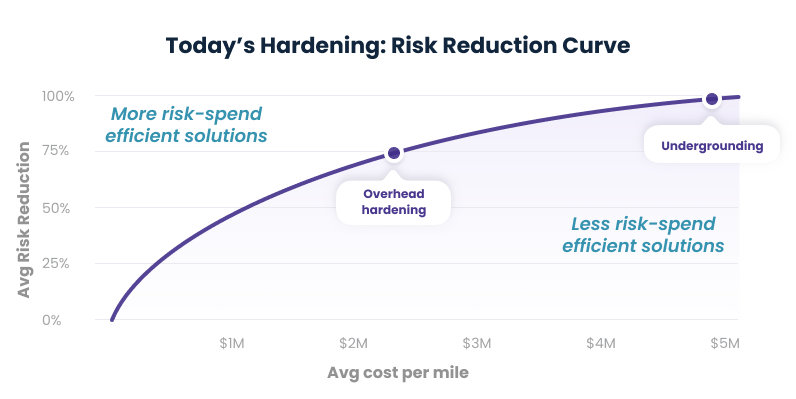As system hardening focuses on updating overhead lines and equipment, PG&E has to consider over 30,000 line-miles of transmission and distribution assets in High Fire-Threat Districts in its operation. Industry-wide adoption of lighter, stronger, and/or more heat-resistant infrastructure has been limited by cost, availability and longevity.
Sponsored by

Problem
Undergrounding distribution power lines eliminates almost all risk of infrastructure-caused wildfire ignitions; however, the process can be costly, slow, and bounded by physical limitations and irregular terrain. While these constraints have limited the extent of undergrounding in the utility sector, efforts to bring conduit at or below grade could be accelerated if the process could be faster and less costly.
Desired properties
- Enable undergrounding for at a meaningfully lower cost across diverse terrain conditions
- Surveying and mapping of trenching hazards such as boulders and other utility infrastructure
- Level-grounding system for electrical conductor
Specifications
Category 2: Alternatives to current undergrounding methods, including level-grounding
Problem statement
Undergrounding electrical lines eliminates nearly all risk of wildfire ignitions from transitioned electric assets. However, this process is currently expensive, labor-intensive, and often subject to physical limitations: the undergrounding construction process requires more space than overhead lines, is more disruptive and intrusive, and therefore typically occurs along main roads. Further, undergrounding is most useful in remote areas with irregular and rough terrain. Due to these constraints, undergrounding makes up only a small portion of grid hardening efforts nationwide. As PG&E plans to harden thousands of line-miles in coming years, finding novel ways to reduce the cost, time, complexity and uncertainty of undergrounding could substantially benefit utilities, landowners, and communities across California.
Possible approaches
Any technical solution or process innovation that provides cost-effective alternatives to overhead lines is welcome. One possible approach is through level-grounding infrastructure for the conduit, as opposed to under-grounding. Surveying technologies such as radar-based drone/computer vision mapping and real-time trenching guidance could reduce complications of the undergrounding process. Another area of opportunity is reducing the time and labor required for trench digging, including robotic boring and excavation, reducing the footprint required for burying lines (necessary for installation next to narrow mountainous roads and in scenic areas), and/or new techniques for installing, maintaining and accessing wires underneath roads.
| Industrywide Market Gap | Potential Solution Category |
|---|---|
| Undergrounding excavation with today’s technology is complex, adding time and cost. | Level-grounding of conduit (e.g. surface troughs) Automation of trench digging |
| Major hazards (e.g., rocks, other utility lines, etc.) often lie underneath existing rights of way and can cause unforeseen delays in the undergrounding process. | Underground hazard identification prior to trenching (e.g. surveying technologies such as ground-penetrating radar) |
| Roads may need to be shut down for undergrounding for extended periods of time because undergrounding adjacent to or under roads requires significant area for conduit and access boxes. | Reduce either construction footprint or installation footprint required for undergrounding, e.g. allow undergrounding to take place on the side of the road without impairing traffic flows, and in narrow areas New techniques for accessing and maintaining wires underneath roads |
| Terrain in High Fire-Threat Districts is often irregular, making undergrounding challenging. | Drone/computer vision mapping and 3D printing of utility infrastructure embedded with the terrain |
Known approaches not of interest
Software-based and procedural management solutions are not of interest.
Key success criteria
Required:
- Enable level-grounding or undergrounding at a cost of no more than $2M per mile, including labor (see cost / risk reduction curve below)
- At least 35% reduction in cost for the same wildfire risk reduction or at least a 35% reduction in wildfire risk at the same cost
- Demonstrated improvement over current state of the art technology
Desired:
- Commercially deployable within 4 years

*Note that this graph is illustrative and not necessarily representative of current costs.
